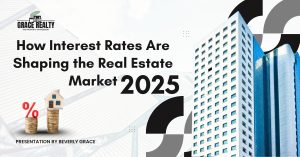Introduction: The Great Lifestyle Shift
Over the past few years, the U.S. real estate market has witnessed a dramatic shift in where people choose to live. The debate between urban vs. suburban living has never been more relevant. As remote work, lifestyle preferences, and affordability continue to shape housing decisions, homebuyers are asking one big question:
Is it smarter to buy in the city or move to the suburbs in 2025?
Whether you’re a first-time buyer looking for value or a seller trying to time the market, understanding the latest trends in urban and suburban real estate can help you make the right move.
1. The Urban Comeback — But Not Everywhere
After the pandemic pushed people toward suburbs, many expected cities to lose their shine. Yet in 2025, urban living is making a comeback, particularly in vibrant, walkable, and job-dense areas.
According to the National Association of Realtors, downtown condo sales and rental demand have increased in major metros like Tampa, Miami, and Austin—driven by young professionals and investors seeking long-term appreciation.
Key drivers of urban resurgence:
- Walkability & access: Easy commutes, entertainment, and cultural attractions remain major draws.
- Luxury redevelopment: Old commercial spaces are being converted into upscale apartments and mixed-use communities.
- Tech and healthcare jobs: Growing industries keep drawing skilled workers to urban cores.
Still, affordability remains a barrier. In markets like Miami or San Francisco, the median condo price is 35–50% higher than nearby suburban homes, pushing some buyers to look beyond city limits.
2. The Suburban Advantage — Space, Stability, and Lifestyle
While cities are regaining attention, suburbs continue to dominate sales volume. In areas surrounding Sarasota, Clearwater, and Naples, suburban developments are seeing strong appreciation fueled by families and remote workers.
Why suburbs still win for many buyers:
- Affordability & space: You can get more square footage and yard space for the same price as a small condo downtown.
- Community living: Access to good schools, parks, and safer neighborhoods appeals to families and retirees.
- Hybrid work: With flexible work arrangements, many buyers prioritize comfort over proximity to the office.
In fact, suburban homes accounted for nearly 63% of all single-family sales in 2024, according to Redfin data. Many buyers report that the “quality of life per dollar” remains highest in suburban ZIP codes.

3. Lifestyle Trade-Offs: What Buyers Should Consider
Choosing between city and suburban living isn’t just financial — it’s about lifestyle. Here’s how the two options compare for modern buyers:
|
Factor |
Urban Living |
Suburban Living |
|
Commute & Accessibility |
Walkable, close to public transit, near workplaces |
Longer commutes, need for a car |
|
Housing Costs |
Higher per sq. ft., lower yard space |
More value, larger homes |
|
Lifestyle & Amenities |
Trendy restaurants, nightlife, cultural spots |
Peaceful environment, parks, family spaces |
|
Investment Potential |
Faster appreciation in prime markets |
Slower but more stable long-term growth |
|
Target Demographic |
Professionals, investors, singles |
Families, retirees, remote workers |
Bottom line:
If you value convenience and energy, urban life might suit you. If you want space and serenity, suburban living offers unbeatable comfort.
4. The 2025 Market Outlook — What’s Actually Winning?
In 2025, suburban real estate still edges out urban properties in terms of sales growth and affordability. Mortgage rates have stabilized near 6–6.5%, keeping suburban homes attractive for long-term buyers. However, urban rental demand is accelerating, making cities a great opportunity for real estate investors.
Emerging trends shaping the 2025 market:
- Hybrid migration: Buyers purchase in close-in suburbs that offer both city access and suburban comfort.
- New construction boom: Builders focus on master-planned suburban communities with smart home tech and eco-friendly designs.
- Investor attention: Institutional investors are buying suburban single-family homes for stable cash flow.
This “blended market” means both lifestyles are thriving—depending on buyer priorities and financial goals.
5. Investment Perspective: Where the Smart Money Is Going
Investors know that diversification is key — and many are splitting portfolios between urban rentals and suburban long-term holds.
- Urban investors target short-term rentals, condos near universities, and luxury units in walkable districts.
- Suburban investors focus on single-family rentals in growing commuter belts and low-tax counties.
In Florida’s Gulf Coast, suburban markets like North Port, Bradenton, and Palm Harbor offer strong appreciation potential with lower entry costs. Meanwhile, downtown Sarasota or Tampa condos appeal to investors seeking high rental yields.
6. Buyer & Seller Tips for 2025
For buyers:
- Define your priorities — space vs. access.
- Use online tools and neighborhood guides to compare commute, schools, and amenities.
- Get pre-approved early — competition remains strong in both urban and suburban markets.
For sellers:
- Highlight lifestyle benefits in your listing: walkability for city homes, family life and space for suburban ones.
- Stage your home to appeal to your target audience.
- Price competitively — buyers are savvy and have more options.
Conclusion: The Winner Depends on You
So, which lifestyle is truly winning in today’s market — urban or suburban?
The real answer: it depends on your lifestyle, budget, and long-term goals.
Urban living offers energy, opportunity, and convenience — ideal for professionals and investors. Suburban living provides space, peace, and stability — perfect for families and remote workers. Both are thriving in 2025, but the suburbs hold the affordability edge, while urban markets promise faster appreciation.
At Grace Realty & Property Management, our experts can help you find the perfect balance — whether it’s a downtown condo or a family home along Florida’s Gulf Coast.





